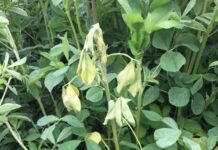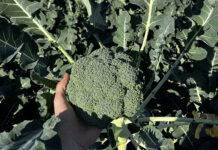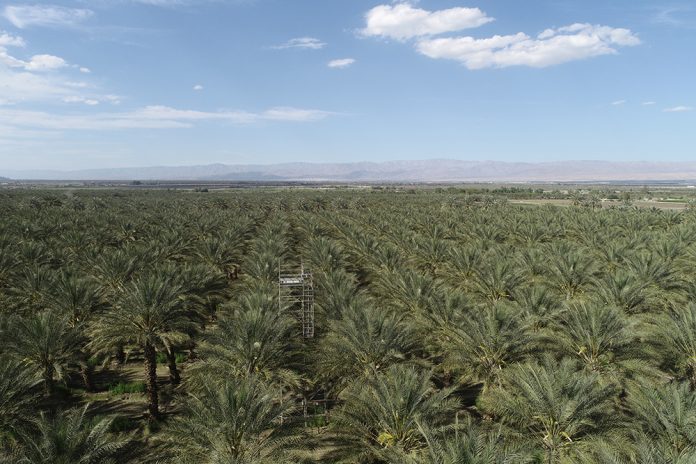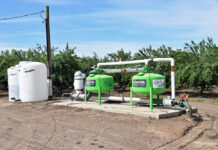Dates (Phoenix dactylifera L.), one of the world’s oldest cultivated fruits, originated in the Middle East, with its distribution extending to the U.S. in the last century. The geographical distribution of commercial date production is limited to arid and semi-arid regions where there is not abundant water supply. The low desert of California with nearly 11,000 acres of date palms is the major date production area within the U.S. followed by Arizona (Montazar et al. 2020). Since the date industry is currently economically successful and robust in California, date production is expected to increase as many new groves have been planted in recent years and more are currently being planted.
The date palm is drought tolerant; however, more accurate irrigation scheduling and water management during its flowering and fruiting season is critical for healthy date palms and high-quality fruit production. Date palm growers have started to adopt the use of microirrigation, but in many instances, irrigation management is based upon data developed decades ago in flood-irrigated orchards.
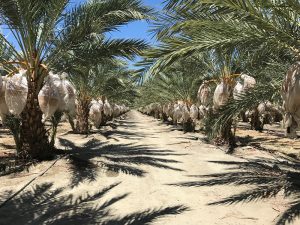

An irrigation study was conducted to acquire relevant information on crop water consumption and develop more accurate crop coefficients values for date palms in California. Extensive data collection was carried out in six mature date palm orchards in the Coachella and Imperial valleys over a three-year period. The experimental orchards represent various soil types and conditions, irrigation management practices, canopy features and the most common date cultivars in the region (‘Medjool’ and ‘Deglet Noor’). The orchards have relatively heterogeneous soil; however, the dominant soil texture varies from sandy loam to silty loam and silty-clay loam. A combination of surface renewal and eddy covariance equipment (flux tower, Figure 2) was utilized to measure actual crop evapotranspiration (ETa) at each site. This article provides some effective irrigation and water management tips in California date palms based on the findings of this study.
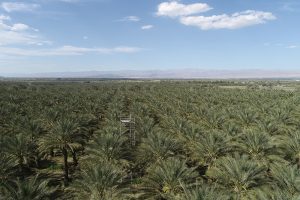
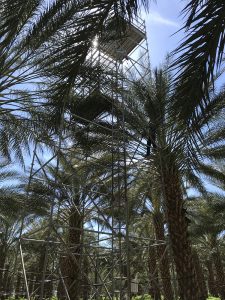
Both micro/drip and flood irrigation are common practices in the low desert region, and some growers, who have installed microirrigation systems in their orchards irrigate their date palms through an integrated micro-flood irrigation system (Figure 1). The results of our recent date palm irrigation management survey demonstrated 31% of grower responders use only flood irrigation, 19% use only microirrigation and 50% follow an integrated micro-flood irrigation management approach. The survey also illustrated drip irrigation systems dominate microirrigation systems, with nearly 88% of grower responders reporting using drip irrigation and 12% using microsprinkler irrigation.
Consumptive Water Use in Date Palms
The results of this study demonstrated considerable variability in date palm consumptive water use (Figures 3 and 4). The cumulative date palm water use over a 12-month period across the six sites ranged from 51.7 in. (site 5) to 59.1 in. (site 3) with a mean daily ETa of 0.28 in d-1 in June-July and 0.04 in d-1 in December at the site with the highest crop water consumption.
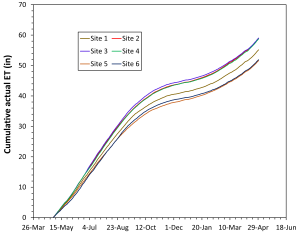
The results revealed clearly that water consumption of date palms varies significantly depending upon site-specific conditions. Various factors may influence date palm crop water use including irrigation management practices, salinity and/or soil differences, groundwater table and ground shading or canopy cover (and tree height), this last providing a good estimation of canopy size/volume and the amount of light that it can intercept. For instance, the cumulative consumptive water use over the 12-month period was 58.8 in. in a non-salt-affected sandy loam soil date palm under flood irrigation (site 4) with an average density of 50 trees per acre and an average canopy cover and tree height of 81% and 36.1 ft., respectively. In comparison, the cumulative annual consumptive water use was determined to be 51.7 in. in a silty clay loam saline-sodic date palm (site 5 under an integrated microsprinkler/flood irrigation system) with an average canopy cover of 55%, density of 60 trees per acre and tree height of 24 ft.
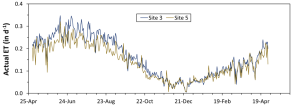
Crop Coefficient Values for Date Palms
The results indicate that there is substantial difference in crop coefficient (Ka) values of date palms, both spatially and temporally (Figure 5). For instance, at site 4, the average monthly crop coefficient value varied between 0.64 in December and 0.88 in June. Date trees at this site experienced mild to moderate water stress during July, but soil moisture was maintained at a desired level during the remainder of the study period.
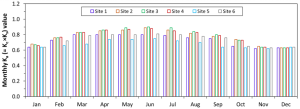
The soil types and conditions at sites 2, 3 and 4 were similar, and the canopy features were relatively similar as well. Both sites 3 and 4 had a density of 50 plants ac-1, whereas the density was 52 plants ac-1 at site 2. All three sites had the ‘Deglet Noor’ date cultivar. Slight differences were found among the monthly crop coefficient values of these orchards that were likely related to irrigation management differences. An integrated irrigation system consisting of drip and flood irrigation was used at sites 2 and 3. Both sites are considered fully irrigated orchards over the study period with the water applied of 7.7 ac-ft/ac at site 2 and 7.9 ac-ft/ac at site 3, with relatively high soil water availability the entire season. The average Ka values for the 12-month period were 0.81, 0.82 and 0.81 at sites 2, 3 and 4, respectively. Within the year, the monthly range of values was from 0.63 (December) to 0.90 (June) at site 3. These values likely represent the ‘potential’ Kc values for the date palms since the applied irrigation water in these orchards were 50% to 60% higher than the measured ETa and both soil moisture and canopy temperature data suggested that no water deficit occurred over the 12-month period.
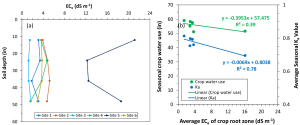
The monthly Ka value varied from 0.62 in November to 0.75 in June at site 5. This orchard is regularly irrigated by micro-sprinkler and occasionally flood irrigated to leach out heavy salt accumulation in the entire soil profile. Across the six sites, sites 3 and 5 had the highest and lowest Ka values averaged over the 12-month period, respectively. An average 12-month Ka value of 0.70 was obtained at site 5, which is nearly 17 % lower than the average 12-month Ka value of site 3. These sites have the same date cultivar (Deglet Noor); however, site 5 had a higher planting density and smaller trees. The reduction of tree growth at site 5 is likely associated with the physiologic adjustment of trees to the long exposure to high salinity-sodicity environments.
Soil Salinity and Date Trees’ Growth
Soil salinity varied considerably amongst the experimental sites (Figure 6, see page 12). The mean ECe (soil electrical conductivity) at the experimental sites showed that while the entire soil profile is saline at the site close to the Salton Sea (site 5, average ECe of the top 4 ft. of the soil > 12 dS m-1), relatively low values of ECe (average ECe of the top 4 ft. of the soil < 5 dS m-1) were observed within the crop root zone at the other experimental sites. The soil particle size distribution at site 5 has higher clay content below the topsoil than the other sites, which along with a high content of soluble salts and high soluble sodium resulted in both water penetration and subsurface drainage problems.
To quantify the impacts of salinity on date palm crop water use, the relations of cumulative ETa and mean annual actual crop coefficient as a function of ECe were derived. Inverse relationships were found between the seasonal actual ET and ECe; and between the mean annual Ka and ECe (Figure 6b). The average ECe of the entire soil profile (4 ft. depth) from the soil samples at each date palm site were used in this analysis to represent an average ECe for the corresponding orchards. As was mentioned, other drivers are involved in ETa and Ka values including canopy features and cultivars, soil types and irrigation management practices. These parameters do not directly contribute to the observed linear relationships; however, they indirectly influence the results. For instance, the reduced vegetative growth at site 5 may have resulted from salinity and drainage issues and the soil properties. The soil is categorized as “silty loam” with silt content greater than 50% at the top 1.2 m, and therefore, it has a very low infiltration rate. Average weight of date fruits was 31% lower at site 5 in compared with site 4 (both are ‘Deglet Noor’ cultivar).
Earlier studies indicated all aspects of date palm vegetative growth may negatively respond to salinity including the rate of production of new leaves and the size of the leaf canopy Zapata and Martinez-Cob 2002; Tripler et al. 2007). The percentage of light interception was 30% lower in the date palm irrigated by saline water (15.0 dS m-1) in a recent study (Al-Muaini et al. 2019).
Recommendations
Date palms need variable amounts of irrigation water depending on time of year, canopy cover percentage and tree height, soil types and conditions, and irrigation management. To sustain date production in the desert region, growers need to integrate microirrigation and flood irrigation together. It helps to fill the soil profile for this deep-rooted tree crop specifically at the time that drip irrigation does not have the capacity to accomplish this. During mid-June to early July, one might need to apply more than 100 gallons per day per tree. Depending on the capacity of the microirrigation system, it would be beneficial to have one flood irrigation during this period. Another flood irrigation during early season (March) is also recommended. We need to keep in mind that effective irrigation management in the desert environment is different than other regions. In the desert environment, irrigation needs to maintain crop water needs and soil salinity at the same time even for an adapted and stress-tolerant crop such as date. The two or three flood irrigation events (depending on the soil types and conditions) integrated with drip irrigation can maintain crop water needs and salinity and optimize the economic benefits of date production in the low desert region.
Growers may use the crop coefficient values developed by this study along with CIMIS ETo data to calculate crop water needs in different times of year. It is highly recommended that growers monitor soil moisture at least at the depth of 1 to 2 ft. Soil moisture at the depth of 1 to 2 ft. is a good indicator of soil water availability to date palms under microirrigation (a threshold of 25 to 30 centibar could be considered for the sandy loam soils in the Coachella Valley.)
References
Montazar, A., Krueger, R., Corwin, D., Pourreza, A., Little, C., Rios, S., Snyder, R.L. 2020. Determination of Actual Evapotranspiration and Crop Coefficients of California Date Palms Using the Residual of Energy Balance Approach. Water, 12 (8), 2253.
Zapata, N., Martínez-Cob, A. 2002. Evaluation of the surface renewal method to estimate wheat evapotranspiration. Agric. Water Manage., 55(2), 141–157.
Tripler, E., Ben-Gal, A., Shani, U. 2007. Consequence of salinity and excess boron on growth, evapotranspiration and ion uptake in date palm (Phoenix dactylifera, L., cv. Medjool). Plant and Soil, 297:147–155.
Al-Muaini, A., Green, S., Dakheel, A., Abdullah, A., Abou-Dahr, W., Dixon, S., Kemp, P., Clothier, B. 2019. Irrigation management with saline groundwater of a date palm cultivar in the hyper-arid United Arab Emirates. Agric. Water Manage., 211 (1): 123-131.



